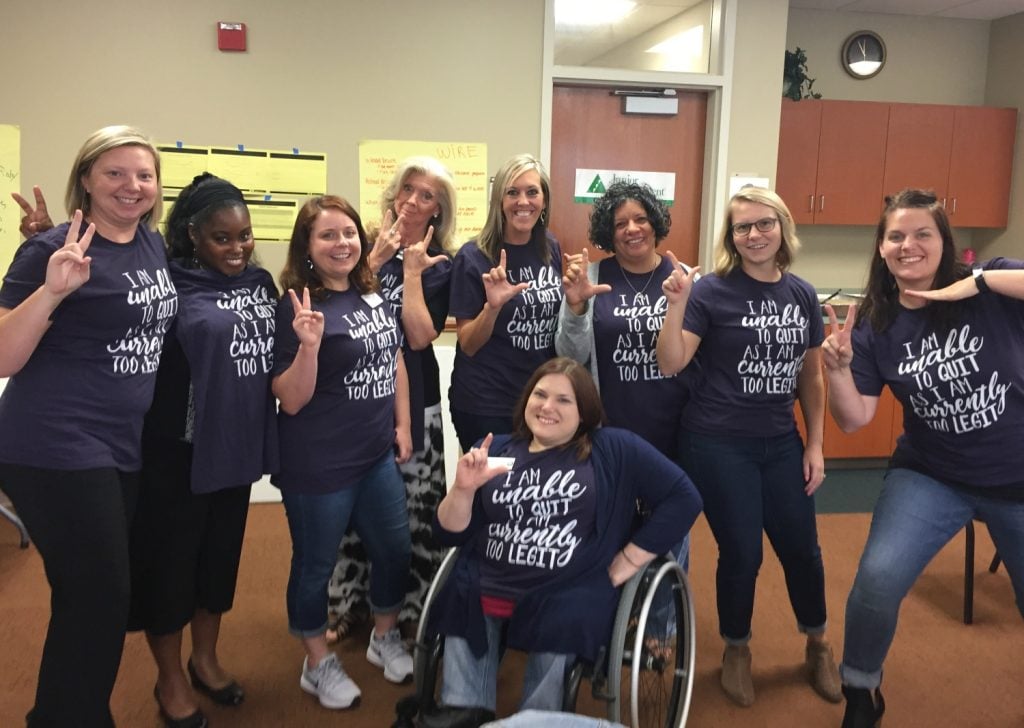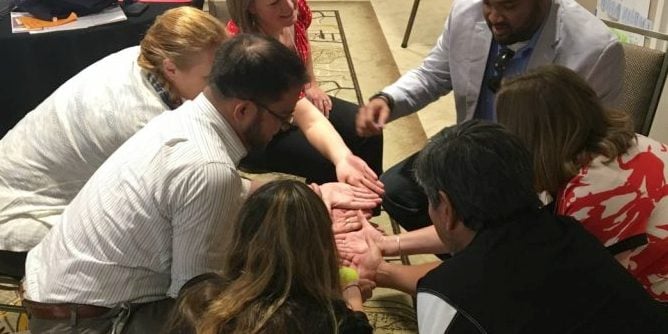| These insights about team composition and other learnings from building capabilities collaboratively will be shared at the 2018 Carnegie Foundation Summit on Improvement in Education, April 3-5. Attend StriveTogether’s workshop, Building Improvement Science Capability Across Communities to Achieve Systems Change, on Thursday, April 5, at 10:15 a.m. PT. |
When I was in fourth grade, we played kickball almost every day at recess. There was a boy named Derek who was always picked first; he could kick the ball the farthest. Ashley was picked next as the fastest runner; then Dan, the precision pitcher. Even as 9-year-olds, we intentionally built our teams to achieve our intended result: to win the game! The same intentionality is needed when bringing together local leaders and other community members to collaboratively improve educational outcomes for kids.
Local partnerships across the StriveTogether Cradle to Career Network work hard to ensure the right individuals and organizations are involved in efforts to advance their result: ensuring every child has the opportunities he or she needs to be successful, from cradle to career. The same process applies when communities participate in StriveTogether programs, such as the StriveTogether Leadership Program or Impact and Improvement Networks, which build the capabilities of cross-sector leaders and practitioners.
StriveTogether uses a team-based approach when strengthening professionals’ skills to get better results for kids. This isn’t professional development where participants spend a day watching a PowerPoint presentation and then put the training binder in the bottom desk drawer. Each community selects a cradle-to-career outcome to work on (what StriveTogether calls the team’s “result”), and team members immediately apply the competencies and skills they are learning to improve that result. The work they do in the leadership program or improvement network is intended to be their “real work,” not a side project. That’s why team composition is so important.
Over the past few years, StriveTogether has seen teams excel or struggle in capability-building programs because of their composition. Here are some initial learnings on how to build the most effective cross-sector team to accelerate results for kids:
Each team member should have a clear connection to the result.
Don’t invite Jim to be a part of the team just because you like Jim or because Jim is always involved. If your result is third-grade reading, be clear on what Jim’s specific contribution to early grade literacy is.
This doesn’t mean your team should only include the “usual suspects,” like teachers or principals. For example, The Road Map Project’s StriveTogether Leadership Program team included a representative from its local housing authority. This employee works on educational programs in the housing complexes that are home to many of the students they are trying to support. Work groups in Austin addressing kindergarten readiness had participants from health and mental health organizations so that they were able to address key factors contributing to a child’s development. Involving multiple sectors and organizations will ensure the team is able to leverage a variety of resources, perspectives and strategies. These individuals can work on how they can best align their actions over the course of the leadership program or improvement network.
Nevertheless, you should be able to say, “We are forming a team to work on (this result), and Jim, we would like you be to on the team because (Jim’s direct connection to the result.)”
The team should include individuals with various levels of authority and closeness to the result.
Often when brainstorming potential team members, the first list of names is a “who’s who” of your local education or nonprofit community, such as school district superintendents, executive directors of nonprofits or prominent funders.
These are all important players who will need to be involved in the work, but StriveTogether has found that the most effective teams have representation of both leaders and practitioners.
The reason this combination works is because the team can tackle the work from multiple angles. Often having direct access to kids, practitioners bring unique perspectives about the challenges that need to be solved and are often best -equipped to test changes on the ground. The leaders on the team can help scale and spread effective practices discovered through those small tests but also are engaged in tackling systemic changes needed to improve the result.
You can check if you have representation from multiple levels of the system with a results at the center chart, a Results CountTM tool developed by the Annie E. Casey Foundation. After placing the result in the center of the chart, communities map which stakeholders are involved, organizing them by sector and how close they are to the result. For example, in a K-12 school district, teachers and counselors may be nearer to the result than superintendents because of the nature of their roles. This visual tool allows communities to see where there may be potential gaps based on sector or proximity to the result.
The team should be authorized by the larger community to do this work but also should be prepared to engage the larger community to make it happen.

A StriveTogether community maps which stakeholders need to be involved in the planning and implementation of strategies to reduce chronic absence using a results at the center chart.
No one individual can do all that is needed to ensure that every child succeeds from cradle to career, and neither can the four to five individuals who are a part of the leadership program or improvement network team. They will need to build a coalition of changemakers who are ready to work on their result back home, but they also will need approval to be doing the real work in the room during the program or network. It is a tricky balance of ensuring that the broader group of stakeholders are informed and engaged throughout the program while not requiring the team to seek a full committee’s approval on every decision. Have conversations upfront about who really needs to be in the room during program sessions to design solutions versus who will need to authorize the work or give feedback on it along the way. The team must be empowered to lead the charge and trusted to bring the work (as well as competencies and skills) back to the larger community.
The team should be representative of the community it is intended to serve.
StriveTogether believes that efforts to improve educational outcomes must be done with — not for — the children and families being served. The team and the broader coalition should include diverse perspectives and reflect the community in aspects such as race, ethnicity and income. Teams participating in the StriveTogether Leadership Program and Impact and Improvement Networks identify disparity gaps in their communities and set targets for closing them. Achieving those targets requires a deep analysis of what factors are causing the inequities and the thoughtful development of strategies to address them. Having varied backgrounds around the table can combat prevalent assumptions around why disparities exist and spur innovative strategies to create more equitable systems.
Each team member should be motivated to use him or herself as an “instrument of change.”
There is an irony in collective impact that aligned, collaborative action actually requires individuals to make changes that contribute to the result. The team should not perceive themselves as an advisory group that makes a list of things that someone else should do. Each individual team member must be willing to roll up his or her sleeves. That means someone who sounds like they would be a good fit for the team on paper — based on their title or organization — might not be the right candidate if they don’t have the personal motivation to achieve the result. These teams are about moving from talking about the problem to acting on it!
Once the individuals are selected, help them become a team.

The third-grade reading proficiency Impact and Improvement Network team in Tulsa, Oklahoma, demonstrates team spirit, featuring their team name “2 Legit to Quit.”
Often, the four to five people who are selected to be a part of the leadership program or improvement network team have not worked closely together before. In the first session, they may introduce themselves to other team members. Important steps include ensuring there are opportunities and structures for them to build relationships with one another, set team norms and establish how they will check in with each other and get work done between sessions. One of the first things StriveTogether does in Impact and Improvement Networks is to have each group develop a team name, which requires them to work together and make a decision around a simple task early on and also allows them to form a single, unifying identity.
Building the right team to improve a result for kids sounds straightforward in theory, but in practice, it is often more of an art than a science. Team composition is critical to the success of cross-sector work, because cradle-to-career partnerships are founded on the principle that those who care about a community’s children can accomplish more by working together than by working apart.






